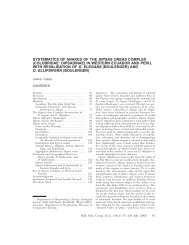cryptic species within the dendrophidion vinitor complex in middle ...
cryptic species within the dendrophidion vinitor complex in middle ...
cryptic species within the dendrophidion vinitor complex in middle ...
Create successful ePaper yourself
Turn your PDF publications into a flip-book with our unique Google optimized e-Paper software.
SPECIES IN THE DENDROPHIDION VINITOR COMPLEX N Cadle 193<br />
torum but <strong>the</strong> color pattern and low<br />
subcaudal counts (115–116) of <strong>the</strong>se specimens<br />
confirms <strong>the</strong>ir identity as D. <strong>v<strong>in</strong>itor</strong>.<br />
Whe<strong>the</strong>r this is a peculiarity of this population<br />
or whe<strong>the</strong>r divided anal plates occur<br />
with low frequency <strong>in</strong> o<strong>the</strong>rs is unknown<br />
(but see comments on historical records <strong>in</strong><br />
Distribution). No o<strong>the</strong>r characteristic of<br />
<strong>the</strong>se specimens is particularly unusual,<br />
although <strong>in</strong> UTACV 22755, <strong>the</strong> last ventral<br />
plate is also divided. At least three o<strong>the</strong>r<br />
<strong>species</strong> of Dendrophidion (D. dendrophis,<br />
D. nuchale auctorum, D. paucicar<strong>in</strong>atum)<br />
are variable <strong>in</strong> <strong>the</strong> s<strong>in</strong>gle/divided nature of<br />
<strong>the</strong> anal plate.<br />
Sexual Dimorphism. A few characters<br />
showed significant sexual dimorphism (Table<br />
1). Although <strong>the</strong> largest specimen is a<br />
male, mean sizes of adult males (542 mm<br />
SVL) and females (535 mm SVL) are not<br />
significantly different (with <strong>the</strong> caveat that<br />
sample sizes are small and sample variances<br />
high). Females have significantly greater<br />
ventral counts than males and <strong>the</strong> posterior<br />
reduction of <strong>the</strong> dorsal scales occurs far<strong>the</strong>r<br />
posteriorly <strong>in</strong> females (mean ventral 99.0, N<br />
5 24) than <strong>in</strong> males (mean ventral 92.8, N<br />
5 18; p , 0.001). In males, <strong>the</strong> dorsocaudal<br />
reduction (8 to 6) occurs at a significantly<br />
more posterior position than <strong>in</strong> females.<br />
Males also have a proportionally longer tail<br />
than females, but males and females do not<br />
differ <strong>in</strong> subcaudal counts.<br />
Coloration <strong>in</strong> Life. Color photographs of<br />
D. <strong>v<strong>in</strong>itor</strong> from Veracruz, Mexico, were<br />
published by Pérez-Higareda and Smith<br />
(1991, pl. 4) and Campbell (1998, fig. 127)<br />
and from Belize by Lee (2000, fig. 315; 5<br />
KU 300784 fide Julian C. Lee, personal<br />
communication). Alvarez del Toro (1972,<br />
fig. 133; 1982, fig. 143) illustrated a<br />
specimen from Chiapas, Mexico, <strong>in</strong> black<br />
and white, and Dugés (1892) provided a<br />
somewhat stylized colorized draw<strong>in</strong>g of a<br />
specimen from Veracruz.<br />
Smith (1941) gave detailed color notes for<br />
<strong>the</strong> holotype <strong>in</strong> life (repeated virtually<br />
verbatim by Taylor [1954: 729–730]), here<br />
paraphrased: Head and temporal region<br />
down to upper edges of two postocular<br />
labials and all of <strong>the</strong> last labial brownish<br />
gray, <strong>the</strong> sutures darker and with a slightly<br />
reddish t<strong>in</strong>ge (lower edge of head cap dark<br />
brown, mixed with dull brownish brick-red);<br />
upper parts of anterior supralabials with a<br />
reddish t<strong>in</strong>ge; supralabials below <strong>the</strong> head<br />
cap pure white; 59 bands on body, 54 on<br />
tail; bands on neck cover<strong>in</strong>g one scale<br />
length, brownish gray laterally, yellow dorsally<br />
and bordered anteriorly, posteriorly, or<br />
both by narrow irregular areas of black; size<br />
of yellow dorsal area <strong>in</strong> light bands decreas<strong>in</strong>g<br />
and eventually disappear<strong>in</strong>g posteriorly;<br />
light bands gradually disappear<strong>in</strong>g posteriorly;<br />
tail bands and those on posterior part<br />
of body black; black borders of light bands<br />
<strong>in</strong>terspersed or <strong>the</strong>mselves bordered by<br />
brick-red, this color especially prom<strong>in</strong>ent<br />
medially; central ground color between<br />
bands brownish gray anteriorly, becom<strong>in</strong>g<br />
light brown t<strong>in</strong>ged with red on <strong>middle</strong> and<br />
posterior body; tail with a stripe of dark<br />
brown (black) <strong>in</strong>terspersed with brick-red,<br />
<strong>in</strong>volv<strong>in</strong>g edges of subcaudals and lower half<br />
of first dorsocaudal row; gular region white;<br />
belly yellow; subcaudals yellow, paler posteriorly.<br />
Alvarez del Toro (1972: 144) described a<br />
specimen from Chiapas, Mexico: ‘‘general<br />
coloration reddish brown, a little grayish<br />
toward <strong>the</strong> sides. On <strong>the</strong> neck are three<br />
yellow bands, and an additional 62 yellowish<br />
ones on <strong>the</strong> body; all <strong>the</strong> bands or bars<br />
bordered posteriorly by narrow black bands.<br />
The lips and throat are white, <strong>the</strong> venter<br />
yellow orange’’ (description repeated by<br />
Alvarez del Toro [1982: 191] except <strong>the</strong><br />
neck bands are said to be orange).<br />
Coloration <strong>in</strong> Preservative. Dorsal ground<br />
color of preserved specimens yellowish<br />
brown, brown, or gray (smaller specimens<br />
usually paler than larger ones). Pale crossbands<br />
yellowish brown to gray. In adults,<br />
posterior pale crossbands become <strong>in</strong>dist<strong>in</strong>ct,<br />
marked only by dark transverse stippl<strong>in</strong>g<br />
with occasional pale flecks dorsolaterally<br />
and <strong>in</strong>dist<strong>in</strong>ct or absent on <strong>the</strong> flanks<br />
(Fig. 3). The number of pale bands/ocelli<br />
on <strong>the</strong> body ranged from 51 to 70 with a<br />
mean and median of 60 and a mode of 59<br />
Bullet<strong>in</strong> of <strong>the</strong> Museum of Comparative Zoology harv-160-04-01.3d 11/4/12 19:58:41 193







